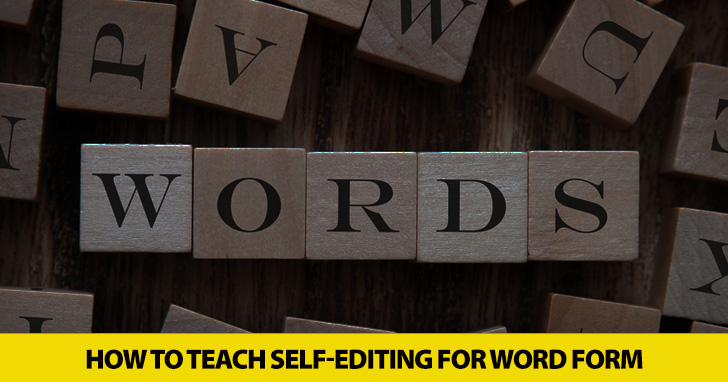She Was Succeeded? She Was Successful? Teaching Self-Editing for Word Form


You have 9 other words to teach along with prediction, and thus you have introduced 10 new words to the students. But what if you could quadruple that without taking more time? By teaching students basic word formation skills early in the term, you can teach them prediction, predict, predictable, and predictably all at the same time. Once you’ve taught students how to manipulate parts of speech in a sentence, they now have increased their vocabulary by four words instead of just one.
Teaching word formation can be challenging, and students can often get confused as to whether they should use the adjective or the adverb. Yet, if you teach them these simple guidelines below, you’ll be ready to start increasing their vocabulary four-fold with every new vocabulary list you provide.

Create a chart/table that has four columns for noun/verb/adjective/adverb and as many rows as new vocabulary words you introduce. It’s beneficial to give students their own individual chart so that they can use it for studying, but it would also be helpful to keep a large chart in the classroom so students can easily be reminded of the patterns found within.
Don’t feel obliged to complete all four columns for every word as not every word in English neatly breaks down into these four word forms. Sometimes a word won’t have all of the forms, or the forms may be rarely used in English. Having gaps in the chart will reinforce the idea that they can’t always apply these patterns.
By using a chart as recommended above, students will also begin to see similarities among word endings. Help them to discover the most common endings for parts of speech and even relationships between parts of speech. For example, guide them to figuring out that adjectives ending in –able/-ible often take the noun ending –ity. (e.g. responsible- responsibility; possible-possibility; capable- capability)
Here are some other patterns to help your students discover within the chart:
Be sure to stress to your students that these are patterns, not “rules,” and that there will be some exceptions to most of these patterns. However, by establishing these patterns concretely, students will be able to vastly improve their vocabulary quickly, and they will more readily notice and remember exceptions to the pattern.
Knowing the correct part of speech for a word form is important, but it’s less than half the battle. The real challenge comes with being able to know how to use it appropriately in a sentence. Below are some (but definitely not all) of the most common usage patterns. Again, emphasize that these are just guidelines because there are many exceptions in English. Once you have taught students these patterns, they will be able to use most word forms immediately in their writing.
Nouns
Nouns are usually in these positions:
Verbs
Verbs are usually in these positions:
Adjectives
Adjectives are usually in these positions:
Adverbs
Adverbs are usually in these positions:

Write each word form on two different note cards (or make things easy on yourself by printing the word forms on the computer and then cutting them into individual words). Divide students into two equal teams and have them sit in two lines facing their opposing team. Distribute one whole set of word forms equally amongst each team such that for every word form, a student on Team A has the word and a student on Team B has the word. Stand in front of the students and call out the word and part of speech you want for that word (e.g., “The noun form for predict”). The first student to raise their hand with the word prediction earns a point for their team. Continue until you’ve gone through all the word forms; keep in mind that going back and repeating word forms you have already called out will help keep all students on their toes and engaged in the activity.
Print off sets of all of your word forms; make sure you have enough for as many groups as you want. Put students into groups of three or four and have them arrange their desks in a small circle with each other. Arrange the word forms evenly on all the students’ desks. At the front, call out a command – “Grab all the adverbs” and students must race the other members of their group to collect as many adverbs as possible. Alternatively, you can follow the pattern of the “Word Up” game in this small group fashion and have students grab the individual word forms that you call out as well.
In groups of three or four, distribute one set of all of the word forms to each group. Each student should have four words in their hand with the remaining words spread out face-down on a desk. Students must ask each other for the appropriate forms that they need to complete a “set” (i.e. adverb, adjective, noun, and verb). For example, Student A might ask Student B if he has the “Noun form of predict.” If he does, Student B must give Student A the form; if Student B does not have it, Student A draws a word form from the pile on the desk.
How do you get students to use word forms correctly?